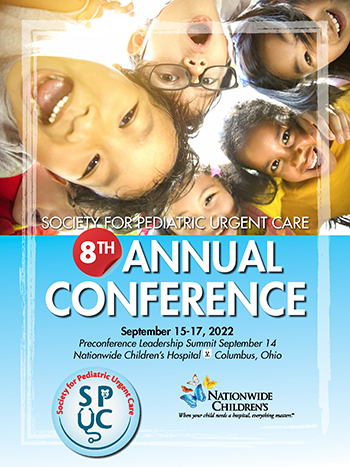This interesting case presented by member Katherine Waller, Pediatric Nurse Practitioner, Children’s Wisconsin, Milwaukee
Brief History
The patient is a 5-year-old female with no significant medical history who presented to a Pediatric Urgent Care Clinic with a chief complaint of a right knee injury.
Details of Injury
Nine days ago was playing at school when a friend collided into her right knee causing her to fall. Fall was unwitnessed and patient is not sure how exactly she fell. Within 24 hours of the injury the patient developed significant right knee swelling. No bruising. Since the injury, pain has been mild, intermittent, and concentrated over the anterior knee. Activity is not limited due to pain and sleep is not disrupted. She is not walking with a limp. Mom’s main concern today is that there has been no decrease in swelling since initial onset. At home Mom has given ibuprofen and the patient has been icing the right knee without improvement in swelling. Denies fever and concurrent or recent illness.
Physical Exam
Lower Extremity Location affected: right knee
Inspection: Obvious deformity of area: absent. Break in skin or abrasion: absent. Bruising: absent. Erythema: absent
Palpation: General: the right lower extremity is warm, well-perfused and with brisk capillary refill. Dorsalis pedis pulse is normal. Sensation of the area is normal.
Tenderness: present. mild over medial and lateral aspects of the knee, moderate over the anterior aspect of the knee.
Swelling: present. significant knee swelling with palpable effusion of the medial and lateral aspects of the knee.
Range of Motion: Full range of motion of the right knee with mild pain in all directions. Full range of motion of hip and ankle without pain. Gait pattern: normal.
Focused knee specific exams: No appreciated laxity with anterior drawer, posterior drawer, and Lachman’s. No click appreciated with McMurray’s Test. Of note, exam very limited by presence of joint effusion which made findings nonspecific.
Diagnostics Performed in Urgent Care
Imaging: XR Knee Right AP Lateral and Sunrise
FINDINGS: There is no visible fracture or other bony abnormality. The alignment of the knee joint is normal. Soft tissue swelling about the knee with large joint effusion.
Urgent Care Plan
Referred to Orthopedic Clinic for further evaluation, treatment, and management of the right knee injury, specifically to rule out ligamentous injury vs. cartilaginous injury vs. occult fracture.
Patient made toe touch weight bearing with assistance of a walker and an ACE wrap was applied to the knee. Due to patient age and size, crutches and knee immobilizer unable to be provided while awaiting Orthopedic evaluation. Instructed on PRICE therapy.
Orthopedic Evaluation
Patient was seen by Orthopedics 5 days after the Urgent Care visit. Physical exam remained unchanged from Urgent Care visit. An MR Knee Right without contrast was ordered and demonstrated no meniscus. ligamentous, or cartilage injury. MRI was significant for a large joint effusion with synovitis and multiple enlarged popliteal region lymph nodes. After MRI, labs were ordered to clinically correlate physical exam and MRI findings. Labs ordered were ESR, CBC w/ differential, CRP, and Lyme AB w/Reflex Western Blot. Lab results confirmed diagnosis of Lyme Arthritis.
Significant lab results:
WBC: 11.1 x10E3/ul
ESR 45 mm/hr
CRP 19 mg/dL
Lyme, Total Ab Test/Reflex
Lyme IgG/IgM Ab 3.71 HIGH
Lyme IgG Line Blot Interpretation: POSITIVE
Lyme IgM Line Blot Interpretation: NEGATIVE
After official diagnosis, Orthopedics transferred care to Primary Care Physician for treatment, management, and follow up. Primary Care Physician consulted Pediatric Infectious Disease and a 28 days course of Doxycycline (4.4mg/kg/day divided into 2 doses) was recommended.
It is important to note that the patient is < 8 years old making Amoxicillin the recommended treatment course due to associated risk of dental staining with Doxycycline use in children younger than 8 years of age. However, rationale for selecting Doxycycline as the treatment of choice was superior central nervous system penetration and a more manageable twice daily dosing regimen. Risks were discussed with parents prior to the start of treatment.
Lyme Arthritis
Lyme disease is the most common tick-borne illness in the United States. Lyme disease is caused by infection with Borrelia burgdorferi, a bacteria carried by deer ticks. Lyme arthritis is a late manifestation of the disease that can result when initial illness goes untreated. Lyme arthritis occurs when Lyme disease bacteria enter a joint space causing inflammation. If Lyme arthritis goes untreated, permanent damage to the joint can occur. The main clinical feature of Lyme arthritis is swelling of one or few joints. The knee is the most common joint to be affected2. Lyme arthritis can develop in weeks to months after initial infection with Lyme bacteria2. In some cases, Lyme arthritis is preceded by the classic erythema migrans skin eruption2. However, in one study of patients with diagnosed Lyme arthritis, it was discovered that 76% of patients did not recall a tick bite, and only 18% of patients had previous eruption of erythema migrans2. These facts alone make Lyme arthritis difficult to clinically correlate, especially in the Urgent Care setting.
An initial episode of Lyme arthritis should be treated with a 4-week oral antibiotic regimen (see table 1 below). For patients that improve after initial antibiotic course, but have persistent symptoms, a second course of the same oral antibiotic should be considered. Patients without any clinical improvement after initial antibiotic course should have therapy escalated to a parental regimen which has a duration of 14 – 28 days (see table 2 below).
See tables 1 and 2 here.
References:
- Centers for Disease Control and Prevention. (2021, October 7). Lyme arthritis. Centers for Disease Control and Prevention. Retrieved February 25, 2022, from https://www.cdc.gov/lyme/treatment/LymeArthritis.html
- Orczyk, K., Åšwidrowska-Jaros, J., & Smolewska, E. (2017). When a patient suspected with juvenile idiopathic arthritis turns out to be diagnosed with an infectious disease – a review of lyme arthritis in children. Pediatric Rheumatology. 15(1). https://doi.org/10.1186/s12969-017-0166-0


